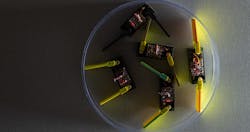Robots Built from ‘Smarticles’ Show New Locomotion Strategy
Building conventional robots typically requires carefully combining components like motors, batteries, actuators, body segments, legs, and wheels. Now, researchers have taken a new approach, building a robot entirely from smaller robots, known as “smarticles,” to unlock the principles of a potentially new locomotion technique.
The 3D-printed smarticles — short for smart active particles — can do just one thing: flap their two arms. But when five of these smarticles are confined in a circle, they begin to nudge one another, forming a robophysical system known as a “supersmarticle” that can move by itself. Adding a light or sound sensor allows the supersmarticle to move in response to the stimulus — and even be controlled well enough to navigate a maze.
Though rudimentary now, the notion of making robots from smaller robots — and taking advantage of the group capabilities that arise by combining individuals — could provide mechanically based control over very small robots. Ultimately, the emergent behavior of the group could provide a new locomotion and control approach for small robots that could potentially change shapes.
The research, supported by the Army Research Office and the National Science Foundation, was published September 18 in Science Robotics. Todd Murphey, professor of mechanical engineering at Northwestern Engineering, along with PhD student Thomas Berrueta and Ana Pervan contributed to the project led by Georgia Institute of Technology.
The researchers modeled the movement of the these smarticles and supersmarticles to understand how the nudges and mass of the ring affected overall movement. Northwestern researchers’ work specifically focused on how the interactions among the smarticles provided directional control.
“These are very rudimentary robots whose behavior is dominated by mechanics and the laws of physics,” said Dan Goldman, a Dunn Family Professor in the School of Physics at Georgia Tech. “We are not looking to put sophisticated control, sensing, and computation on them all. As robots become smaller and smaller, we’ll have to use mechanics and physics principles to control them because they won’t have the level of computation and sensing we would need for conventional control.”
Inspiration came from an unlikely source: a study of construction staples. By pouring these heavy-duty staples into a container with removable sides, researchers created structures that would stand by themselves after the container’s walls were removed.
Shaking the staple towers eventually caused them to collapse, but the researchers realized that simple entangling of mechanical objects could create structures with capabilities well beyond those of the individual components. To explore the concept, researchers used a 3D printer to create battery-powered smarticles, which have motors, simple sensors, and limited computing power. The devices can change location only when they interact with other devices while enclosed by a ring.
“Even though no individual robot could move on its own, the cloud composed of multiple robots could move as it pushed itself apart and shrink as it pulled itself together,” Goldman said. “If you put a ring around the cloud of little robots, they start kicking each other around, and the larger ring — what we call a supersmarticle — moves around randomly.”
The researchers noticed that if one small robot stopped moving, perhaps because its battery died, the group of smarticles would begin moving in the direction of that stalled robot. Researchers controlled the movements by adding photo sensors to the robots that halt the arm flapping when a strong beam of light hits one of them.
“If you angle the flashlight just right, you can highlight the robot you want to be inactive, and that causes the ring to lurch toward or away from it, even though no robots are programmed to move toward the light,” Goldman said. “That allowed steering of the ensemble in a very rudimentary, stochastic way.”
Yet, the interactions among the smarticles can move a robot in expected patterns.
"For many robots, we have electrical current move motors that generate forces on parts that collectively move a robot reliably,” Murphey said. “We learned that although individual smarticles interact with each other through a chaos of wiggling impacts that are each unpredictable, the whole robot composed of those smarticles moves predictably and in a way that we can exploit in software.”
Future work could involve more complex interactions that utilize the simple sensing and movement capabilities of the smarticles. “People have been interested in making a certain kind of swarm robots that are composed of other robots,” Goldman said. “These structures could be reconfigured on demand to meet specific needs by tweaking their geometry.”
The US Army’s interest stems from the potential to create new robotic systems capable of changing their shapes, modalities and functions, said Sam Stanton, manager of complex dynamics and systems at the Army Research Office, an element of US Army Combat Capabilities Development Command’s Army Research Laboratory.
“Future Army unmanned systems and networks of systems are imagined to be capable of transforming their shape, modality and function,” he said. “A robotic swarm may someday be capable of moving to a river and then autonomously forming a structure to span the gap.”
Authored by John Toon, this article originally appeared in the Engineering News blog of the McCormick School of Engineering at Northwestern University. It is republished with permission.
About the Author
Northwestern University Engineering News
News from the blog of the McCormick School of Engineering at Northwestern University.
